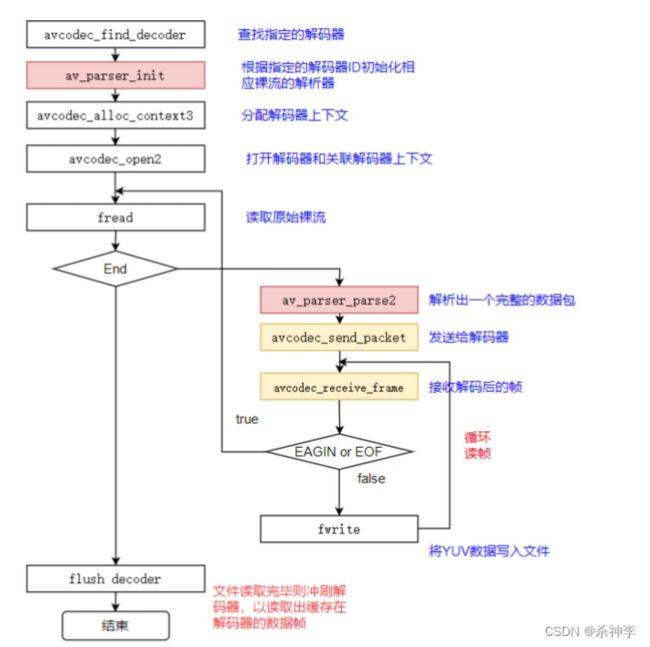ffmpeg 解码本地裸视频流
解码本地视频流基本和解码音频流一致
视频解码过程
FFmpeg流程
关键函数啥的就不多说了 直接看我之前解码音频的文章 代码如下
#include
#include
#include
#include
#include
#include
#define VIDEO_INBUF_SIZE 20480
#define VIDEO_REFILL_THRESH 4096
static char err_buf[128] = {0};
static char* av_get_err(int errnum)
{
av_strerror(errnum, err_buf, 128);
return err_buf;
}
static void print_video_format(const AVFrame *frame)
{
printf("width: %u\n", frame->width);
printf("height: %u\n", frame->height);
printf("format: %u\n", frame->format);// 格式需要注意
}
static void decode(AVCodecContext *dec_ctx, AVPacket *pkt, AVFrame *frame,
FILE *outfile)
{
int ret;
/* send the packet with the compressed data to the decoder */
ret = avcodec_send_packet(dec_ctx, pkt);
if(ret == AVERROR(EAGAIN))
{
fprintf(stderr, "Receive_frame and send_packet both returned EAGAIN, which is an API violation.\n");
}
else if (ret < 0)
{
fprintf(stderr, "Error submitting the packet to the decoder, err:%s, pkt_size:%d\n",
av_get_err(ret), pkt->size);
return;
}
/* read all the output frames (infile general there may be any number of them */
while (ret >= 0)
{
// 对于frame, avcodec_receive_frame内部每次都先调用
ret = avcodec_receive_frame(dec_ctx, frame);
if (ret == AVERROR(EAGAIN) || ret == AVERROR_EOF)
return;
else if (ret < 0)
{
fprintf(stderr, "Error during decoding\n");
exit(1);
}
static int s_print_format = 0;
if(s_print_format == 0)
{
s_print_format = 1;
print_video_format(frame);
}
// 一般H264默认为 AV_PIX_FMT_YUV420P, 具体怎么强制转为 AV_PIX_FMT_YUV420P 在音视频合成输出的时候讲解
// frame->linesize[1] 对齐的问题
// 正确写法 linesize[]代表每行的字节数量,所以每行的偏移是linesize[]
for(int j=0; jheight; j++)
fwrite(frame->data[0] + j * frame->linesize[0], 1, frame->width, outfile);
for(int j=0; jheight/2; j++)
fwrite(frame->data[1] + j * frame->linesize[1], 1, frame->width/2, outfile);
for(int j=0; jheight/2; j++)
fwrite(frame->data[2] + j * frame->linesize[2], 1, frame->width/2, outfile);
// 错误写法 用source.200kbps.766x322_10s.h264测试时可以看出该种方法是错误的
// 写入y分量
// fwrite(frame->data[0], 1, frame->width * frame->height, outfile);//Y
// // 写入u分量
// fwrite(frame->data[1], 1, (frame->width) *(frame->height)/4,outfile);//U:宽高均是Y的一半
// // 写入v分量
// fwrite(frame->data[2], 1, (frame->width) *(frame->height)/4,outfile);//V:宽高均是Y的一半
}
}
// 注册测试的时候不同分辨率的问题
// 提取H264: ffmpeg -i source.200kbps.768x320_10s.flv -vcodec libx264 -an -f h264 source.200kbps.768x320_10s.h264
// 提取MPEG2: ffmpeg -i source.200kbps.768x320_10s.flv -vcodec mpeg2video -an -f mpeg2video source.200kbps.768x320_10s.mpeg2
// 播放:ffplay -pixel_format yuv420p -video_size 768x320 -framerate 25 source.200kbps.768x320_10s.yuv
int main(int argc, char **argv)
{
const char *outfilename;
const char *filename;
const AVCodec *codec;
AVCodecContext *codec_ctx= NULL;
AVCodecParserContext *parser = NULL;
int len = 0;
int ret = 0;
FILE *infile = NULL;
FILE *outfile = NULL;
// AV_INPUT_BUFFER_PADDING_SIZE 在输入比特流结尾的要求附加分配字节的数量上进行解码
uint8_t inbuf[VIDEO_INBUF_SIZE + AV_INPUT_BUFFER_PADDING_SIZE];
uint8_t *data = NULL;
size_t data_size = 0;
AVPacket *pkt = NULL;
AVFrame *decoded_frame = NULL;
if (argc <= 2)
{
fprintf(stderr, "Usage: %s

